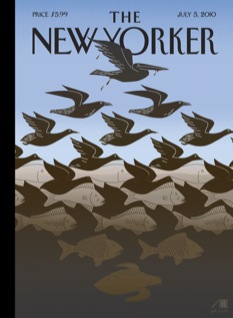The Dry Garden: Zausch and Di
Posted on | July 9, 2010 | No Comments
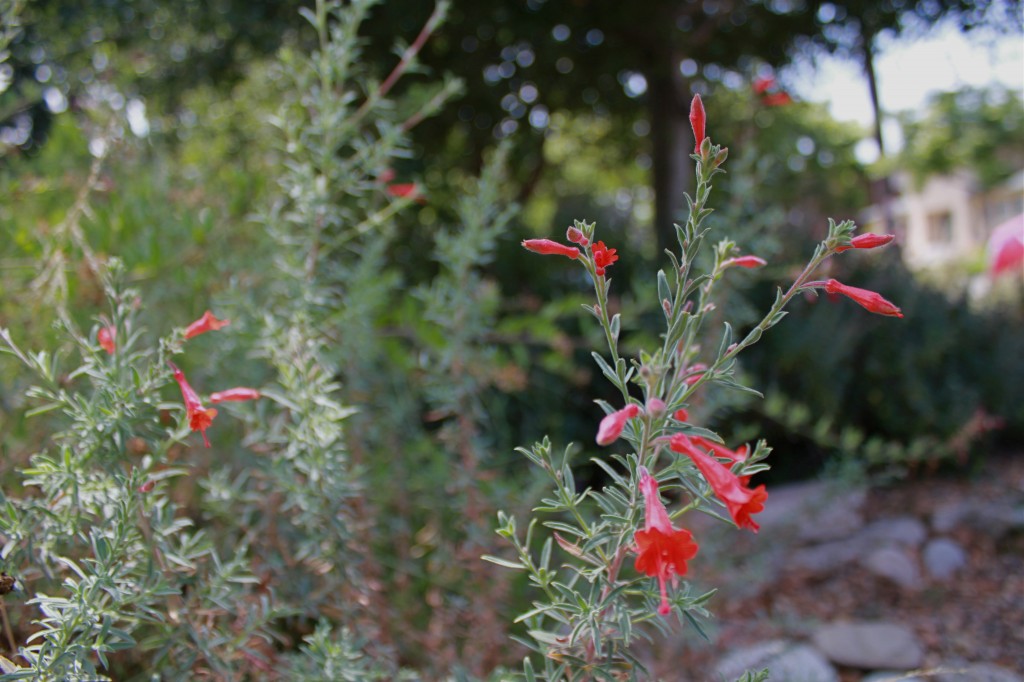 Timing is everything when you’re a plant in a place with little water and lots of competition. Our native California fuchsia, Zauschneria californica, has patience. It remains sedate as the native sages and lilacs burst into spring blossom. Then, as the early bloomers slip into summer dormancy, this discreet gray-green shrub flowers, and flowers, and flowers, often straight through autumn.
Timing is everything when you’re a plant in a place with little water and lots of competition. Our native California fuchsia, Zauschneria californica, has patience. It remains sedate as the native sages and lilacs burst into spring blossom. Then, as the early bloomers slip into summer dormancy, this discreet gray-green shrub flowers, and flowers, and flowers, often straight through autumn.
Click here to keep reading about Zauschneria californica and its Uruguayan counterpart, Dicliptera suberecta, in The Dry Garden in the Los Angeles Times. Or, if you’re too mad to think about good flowering plants for hummingbirds because you really, really hate someone, buy them this book, reviewed today in the Los Angeles Times.
The Clean Water Act applies to the LA River
Posted on | July 8, 2010 | 1 Comment
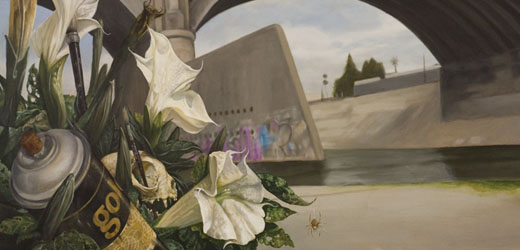
Have concrete, will create. A painting from last year's exhibit “The Ulysses Guide to the Los Angeles River" at the Pasadena Museum of California Art. For background on the show and grafitti culture of the LA River, click on the image.
The US Environmental Protection Agency has reversed an earlier US Army Corps of Engineers classification of the Los Angeles River as un-navigable, a term that exempted it from protection under the Clean Water Act.
After William Mulholland and Los Angeles tapped Owens Valley and the Eastern Sierra for its water in 1913, in the 1930s, the Corps paved the LA River, the city’s original source. This turned the river into a main drain of a county-wide flood control system. The upshot: Los Angeles drained the Eastern Sierra, destroying the once crystaline Owens Lake and nearly destroying the neighboring Sierra Mono Lake, while the city that Mulholland’s aqueduct made possible pumped its own native rainfall along with its unfiltered, highly polluted urban run-off into the Pacific.
Ironically, while the river was paved during the last great economic depression, this recession looks likely to lead to at least partial unpaving and re-naturalizing. This reclassification of the river by the EPA may prove a seminal moment in Los Angeles reforming its long-perverse water management. The Los Angeles Times has the story; an estactic LA Creek Freak has the video and Aquafornia has more links.
UPDATE: 7/9/2010: The Los Angeles Times editorial board is happy too.
‘To catch a raindrop’
Posted on | July 7, 2010 | 3 Comments
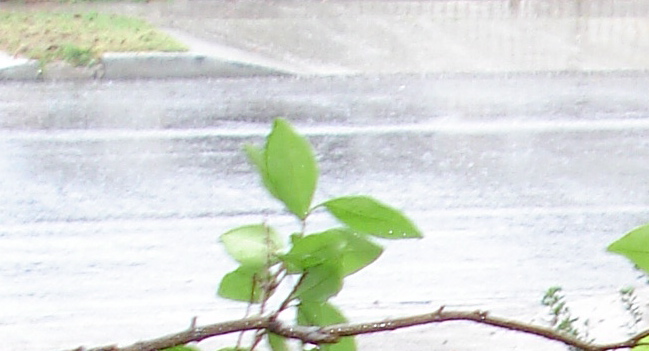
“The water that you’re looking at would all percolate into the ground if it weren’t paved," Mark Hanna, a Department of Water & Power engineer, told Judith Lewis Mernit during a rainstorm last winter. To read Lewis Mernit's story on the lost rains of Los Angeles, click on the image to be taken to the website of the new literary quarterly Slake, or look for Slake from independent booksellers.
A January storm sweeps across the northern Pacific on the jet stream and hits Southern California with prodigious amounts of rain, writes Judith Lewis Mernit in the premier issue of Slake. It brings wind, too: bursts up to eighty miles per hour lop the tops off palm trees, waterspouts swirl, and a small tornado lifts catamarans thirty feet in the air. Here in Sun Valley, in the northern reaches of the San Fernando Valley, hail clatters so loudly on the windshield of Mark Hanna’s city-owned sedan that he has to shout over the din.
“Don’t open your window!” A rooster tail wake splashes high over the door handles as Hanna makes a hard right turn around a flooded street corner. We let out a whoop. With the flushed and wholesome look of a man who’s spent half his life outdoors, Hanna, thirty-eight and a civil engineer at the Los Angeles Department of Water & Power, is the tall, blond, and super-capable guy you’d want piloting your raft on a wicked river trip.
And so we go, navigating roads where ancient streams now wildly reassert themselves, as the falling rain insists on taking historic paths out of the mountains, asphalt be damned. Only an inch of rain will fall today, but in drainage-challenged Sun Valley it’s enough to turn several intersections into turbulent brown lakes by midafternoon.
“The water that you’re looking at would all percolate into the ground if it weren’t paved,” Hanna says. “We wouldn’t even have generated much runoff into the Los Angeles River yet.” The river, when we passed it earlier, was running high, fast, and wild.
To keep reading Lewis Mernit’s piece “To catch a raindrop” in Slake on the lost rain of Los Angeles, you need to buy a copy. The new literary quarterly is available at leading independent bookshops. Click here to find a store.
Turf war continues
Posted on | July 7, 2010 | 1 Comment
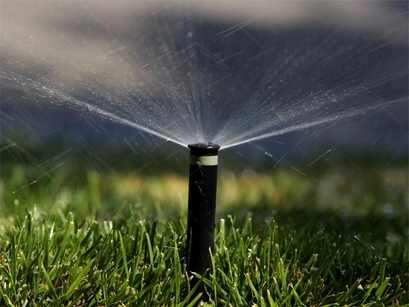 A proposal from Los Angeles Department of Water & Power Commissioners to switch LA’s lawn-watering ordinance from a two-day to a four-day-a-week opposite side of the street regime was rejected yesterday by the Los Angeles City Council, reports the Los Angeles Times. Instead, led by San Fernando Valley councilman Greig Smith, the council countered with a proposal that would allow three-day watering, though for shorter periods. This will be returned to DWP commissioners for consideration.
A proposal from Los Angeles Department of Water & Power Commissioners to switch LA’s lawn-watering ordinance from a two-day to a four-day-a-week opposite side of the street regime was rejected yesterday by the Los Angeles City Council, reports the Los Angeles Times. Instead, led by San Fernando Valley councilman Greig Smith, the council countered with a proposal that would allow three-day watering, though for shorter periods. This will be returned to DWP commissioners for consideration.
Last year, after the two-day rule was instituted by his own chamber, Smith publicly flouted it. “My grass is greener than it’s ever been,” Smith told the Daily News last September, a time of year that lawn is naturally brown. He defended his proposal yesterday by saying that it uses less water because of shorter cycles, with a total of 24 minutes watering a week instead of the two-day system’s 30 minutes.
The upshot of yesterday’s vote: A scofflaw gets his way, Smith can still argue that he is a conservationist while undermining public messaging about lawn watering mid-summer, the City Council gets to continue its browbeating of the Los Angeles Department of Water & Power, and turf is defended while its broadscale use in Southern California is steadily wrecking the environments of the region’s three main water sources, the Colorado River, Owens Valley and Sacramento-San Joaquin River Delta.
The week that was, 6/27-7/3/2010
Posted on | July 4, 2010 | No Comments
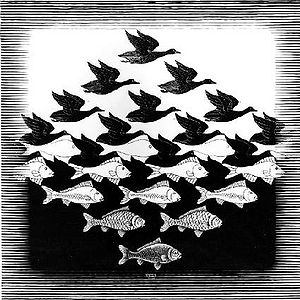
Sky and Water I. Woodcut. MC Escher, 1938. Click on the woodcut for background on the Dutch woodcutter's masterpiece.
The utility burned through nine general managers in 10 years, during which time maintaining the status quo was a much higher priority than moving the City forward. No wonder DWP’s popularity currently resides somewhere between the DMV and BP. — Op-ed by Heal the Bay president Mark Gold, “Power and water don’t mix,” Los Angeles Times, June 30, 2010
… responsibility for water management in Los Angeles is split between two agencies — the Department of Public Works and the Department of Water and Power — with very different missions and approaches… Putting all water issues under one roof would mean that sewage, storm water, flood control, water recycling, conservation efforts and drinking water could be managed in concert, which would produce far greater efficiency. — Op-ed by Heal the Bay president Mark Gold, “Power and water don’t mix,” Los Angeles Times, June 30, 2010
Our next water will be collected from high entropy sources, like stormwater runoff, which is widely distributed and often polluted … — You reap what you sow, Gov. Schwarzenegger, On the public record, June 30, 2010
“It is unpredictable what level of contribution the (North Bay Aqueduct) will have to the county’s long-term municipal supplies. Increased use of recycled water can mitigate the demand on potable water supplies.” — Napa County Grand Jury, Grand Jury: Meld water and sewer agencies, July 4, 2010.* News item via Aquafornia. To read the Grand Jury report, click here.
Click here to keep reading The week that was
« go back — keep looking »